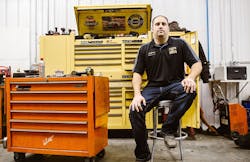SHOP STATS: Matt's Auto Service Center Location: Fargo, S. Fargo, N.D., Moorhead, Mn., Operator: Matt Lachowitzer Average Monthly Car Count: 1,000 (total) Staff Size: 27 (total) Shop Size: 7,500 (average); Annual Revenue; $5 million (total)
Besides keeping track of your customers’ history in your system, how else are you able to tell if a customer frequently uses your services? Whether it’s a familiar face in your shop or a name that writes a review after her appointment—it’s important to know where your loyalty lies when running a business.
For Matt Lachowitzer, MSO of three Matt’s Auto Service Centers in North Dakota, really understanding his demographic was important in running his business, and something he strived to get a handle on consistently.
In 2010, the shop invested in a paper hole-punch card that identified how often a customer came through to the shop.
“We made a paper card and it had a punch on it and that’s how we did it because it was the easiest and cheapest way,” Lachowitzer says.
While it was cheap and provided the shop with insight into how often customers were taking their vehicles into the business, Lachowitzer looked to do more, and ultimately give back to the customers who relied on them for repairs.
“As we got bigger, I started looking at, ‘How do we do this with a card?’” he says.
THE BACKSTORY
Matt’s Auto Service Center was started in 2009 by Lachowitzer, who spent a majority of his time in the industry working at Ford and GM dealerships. The first shop started as a two-bay shop, moved to a four-bay shop, and today is an eight-bay shop.
“In 2012, we opened our first Fargo location, which is our second location, a five-bay shop, and we were in there until 2015 when we moved to our biggest facility, which is a 10-bay shop,” Lachowitzer says. “This year (2018), we actually purchased a body shop and we remodeled it, so now it’s half body, half mechanical, so I do collision and mechanical.”
Between all three stores, the business has 30 mechanical bays and seven collision bays.
THE PROBLEM
While the paper copy showed staff members how often customers were coming into the business, it was unable to properly track customers electronically.
“For me, I like the marketing side of stuff and I want to understand where my customers came from and why they’re coming to us,” Lachowitzer says. “When you have a great customer that tells [other people] about you, they’re a good customer. It was a big deal on, how do we identify those customers and find a way to get more people like them?”
In addition, Lachowitzer was hoping to find a multipurpose card that could serve as a gift card and offer more to his customers.
“As we got bigger, I started looking at how do we do this with a card,” Lachowitzer says.
THE SOLUTION
In 2011, the shop decided to invest in a card that serves as a branded rewards/gift card that can be used for both services. The all-in-one card caters to all three shops and can be used as both a gift card as well as a loyalty card that rewards customers for their business.
Instead of having two cards on hand—one rewards card and one gift card—the two-in-one card eases up stock, making it easier to organize and less of a hassle for the business. When looking for the right card company, the shop sought out a card that they could design on their own in order to further build on their brand, later partnering with Heartland Payment Systems.
“It’s all stored by card number, and when we load a card, we can put all customer’s information in there, and I can log in on the back and see, ‘So and so’s card number is this and has this many dollars and points on it,’” Lachowitzer says. “It makes life easy, especially when you have a good customer that loses their card. I can actually log in and find out what’s on it.”
The card features both a loyalty and referral opportunity where customers can earn back money that is spent with the shop.
“Once it gets past five dollars they can use their—what our customers call—‘Matt’s Bucks,’ for anything they want on any service,” Lachowitzer says. “We have a referral program that refers people to us and anytime someone gives a referral of a new customer, they get $20 loaded on their card as well.”
Since implementing the card, the shop has created an in-house procedure to make sure the referral card is paired with the right customer.
Shop Tip: Determine the Right Customer
Although the program is available for all customers, Lachowitzer finds that some customers might be a better fit for the referral program than others.
“Not every customer is our ideal customer, too, so we want to make sure we find the customer that really gives the five-star reviews and tells people [about us],” Lachowitzer says.
In deciding on the right customer, Lachowitzer says his shop strives for a positive experience that leaves an impact on both the customer and staff member.
“Internally we strive for a hug or high-five moment with everything we do,” Lachowitzer says. “So, if our staff feels like they have that moment with a customer, that’s when we start to bring stuff like this up, or if we notice the last time they came in, they left a five-star review or things like that. Or if they were in two weeks ago, one of their friends from work came in because they had a great experience—those are the kind of people that we send those names right to our marketing team who then send stuff out right away.”
Shop Tip: Check Customer History
When a customer checks in for an appointment, part of the internal process is keeping track of background information such as how they heard about the shop.
“Every customer gets asked (during the checkout process) how did they come to us, so our service advisors cannot write an RO without getting that information—it won’t even let them write down customer complaints,” Lachowitzer says. “So, from there, what they do is say, ‘Who referred you?’ and we immediately react and send a gift card out.”
After the follow-up, the traction generally picks up because of customer excitement, Lachowitzer says.
“The first one you get, if you do a really good job with that customer, when that referral comes in, we immediately call so-and-so, we get it out the same day,” Lachowitzer says. “Then we follow up, thank them for doing that, and what that created is an, ‘They really care about us,’ and then they go tell five more people. And that’s where it’s created its own direction; it doesn’t need a lot of push for us.”
Shop Tip: Discuss After Appointment
After determining if the program is a right fit for the customer, Lachowitzer says customers are approached at the end of their check-out time at the shop about the opportunity.
“Typically we like to do them in person; we’ve done some over the phone and some via email, but I would say 95 percent of them are in person,’ Lachowitzer says. “We try to do that after the buying process is over so they’re done with that and they’re not thinking about that stuff.”
THE RESULTS
Since implementing the program, the shop has seen an increase in customers.
“It’s pretty dramatic, actually, because when you look at how much it costs to acquire a new customer compared to using a referral loyalty program instead, it’s pennies on the dollar compared on what you spend on the advertising money,” Lachowitzer says. “Everything we’ve tried to do, I would rather give the money to my customer than put something on the radio because they’re the ones out there telling people about us.”
According to Lachowitzer, on average, for the 1,000 cars per month that the shop sees, 50–75 of them are referrals. In addition, roughly 2,000 customers are part of the program.
“It’s close to 10 percent of our business is referral customers every single month,” Lachowitzer says.
THE TAKEAWAY
When you’re looking to increase customers at your business, it can be beneficial to take note and recognize those who are loyal to your company.
“If somebody wanted to try something like what we’re doing with our program, [I’d suggest to] make sure you show them how it’s beneficial for them,” Lachowitzer says. “That’s one of the things that we had to do.”
Customers might be more willing to to continue bringing their business to you when they know that their service is appreciated.
“This is one of the easiest ways to do that because you can tell your great customers that already speak from the rooftops about you and say, ‘Hey, by the way, you can get a reward if you tell people that are just like to come to us,’” Lachowitzer says.

